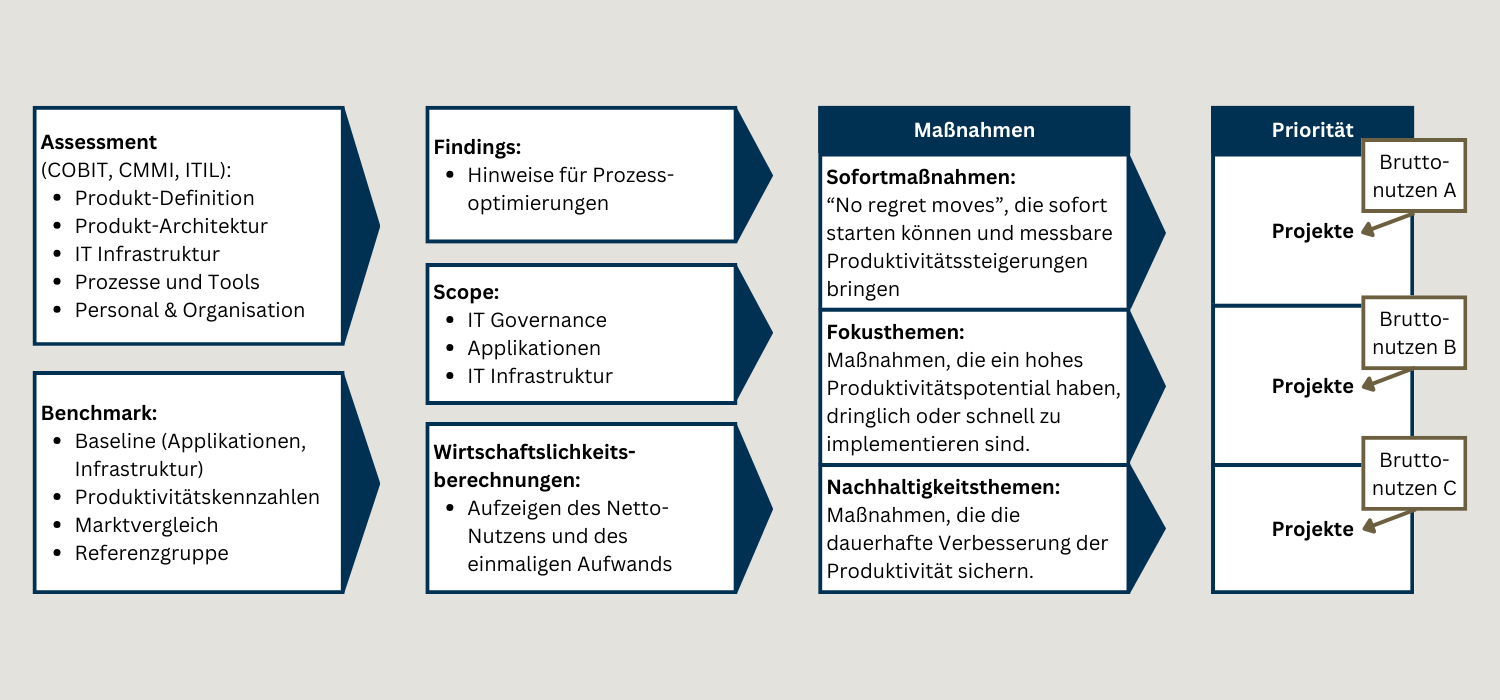Case study: Positioning and orientation with IT benchmarking
In this article, we use an example from our practice to show you how IT benchmarking can be used to determine your own position and make a course correction.
If you don’t like where you are standing, then change your location. You are not a tree.
It is written almost everywhere: if you want different results, you have to do things differently than before. If you don’t like where you are, then change your location, because you are not a tree. Such statements not only apply to personal development or life in general, but also to IT in companies. But before you change your location, you should first realise EXACTLY WHERE you, or rather your IT, is. Because only those who know where they are can move away from there. After all, who wants to walk round in circles when you can have a destination? This is exactly what IT benchmarking enables you to do: determine your position and orientate yourself.
Positioning with IT benchmarking
In this article, we use an example from our practice to show you how IT benchmarking can be used to answer the following questions.
- Is your IT competitive with other companies?
- Is the budget being used economically?
- Can risks be identified? If so, which ones?
- Are the correct control parameters being used?
Initial situation
The IT subsidiary of an international group provides IT services for the group companies worldwide. In order to determine the company’s own performance, an external IT benchmarking is to be carried out. The aim is to obtain answers to the questions posed above.
IT benchmarking procedure
At the suggestion of the BAMAC GROUP, a comprehensive analysis is carried out to implement the benchmark, which focuses on the following:
- the process capabilities in IT (Change, Run) and tools
- Productivity in Change and Run
- the organization & personnel
- the product definition
- the IT architecture

The solution we proposed involved a multi-part analysis of the IT. On the one hand, we collected data through assessment centers and employee surveys, on the other hand we analyzed the IT applications, especially with regard to Change and Run, and finally we ran the IT benchmarking to determine the current situation.
As a result, we received suggestions for improvements, which we substantiated in a profitability calculation. The identified measures were ranked in order of importance (economic potential) and speed of implementation. The resulting list of priorities forms the basis for the implementation phase, where each identified measure is implemented as part of a project. This approach has proven its worth and is an integral part of our working methods.
Overall, our analysis showed a savings potential of 35% of the current budget. In this case, these potential savings should not be used to reduce the budget, but to increase IT output.
Result of the location analysis with IT benchmarking
The results of the investigation led to:
- Measures to increase cost efficiency with regard to
- Plan – Build – Run
- Infrastructure (Workplace / Server / Networks)
- Applications (Change / Run)
- Measures to increase customer satisfaction in the Group companies
- Adaptation or modification of IT portfolio management (process for identifying measures, prioritization and planning, organization, reports)
- Benchmark for classifying performance in application services and infrastructure
- Identification of improvement potentials (development processes, IT infrastructure) and their economic benefit for the company
- Quality in development and operation (e.g. error metrics, service level management)
- Increased efficiency in the provision of new products and organizational maturity (according to CMMI)
Advantages of determining your position with IT benchmarking
The advantages of IT benchmarking can be described in four dimensions.
- Cost optimization
- The identification of potential cost savings has increased the opportunities for implementing innovations. Once these measures had been implemented, the project backlog could begin to be cleared.
- Customer trust
- The survey and the immediate implementation of initial measures have significantly increased satisfaction with IT within the Group.
- Efficiency potential for processes, architecture and infrastructure
- This potential was recognized and exploited, increasing the efficiency of IT in all three areas.
In summary, there was potential for optimization amounting to 35% of the current IT budget. The realization of the identified measures and their implementation already led to an increase in projects in the second year, which were made possible by the released budgets.
Why you should know your location and the fundamental advantages of IT benchmarking can be recognised in the IT benchmarking location determination. Our IT benchmarking case study on the performance of IT products will provide you with further insights into why IT benchmarking can be so decisive for your company’s success.
If you would like to talk the matter over with an expert, do not hesitate to contact us.
Categories of this post
Further interesting posts.






